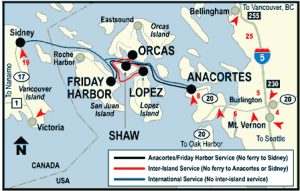Back in January 2013 I accompanied my client John to the future home site in order to get the lay of the land.  It was cold and overcast when we arrived, but it didn’t rain much (the Island gets around 22†of rain per year—a lot less than you would think).
We met with Ron the excavator/septic guy/pilot (the pilot angle will come in handy later) for about an hour.  We determined some potential locations for the septic drain field and our preferred home site.  The poor draining soil would most likely require a mound system (which the test holes later confirmed).  These systems run about $30k on the island.  As a comparison, a conventional system in our area in Clark County, Washington might cost about $5-6k.
Next we discussed the driveway.  There’s an existing dirt driveway that’s been built up along the west property line.  We’ll want to top dress it with rock at some point.  Unfortunately, there’s no quarry on the island so all rock has to be imported by ferry or barge.  It was at this point where I began to wrap my head around the logistics of building a house on an island with boat access only.  I’ll post more on this later.  Needless to say, the cost of placing gravel on the ¼ mile long driveway is going to be a bit more than we’re used to.
As John and I wrapped up our meeting with Ron and began to head to the ferry terminal I started to consider what kind of house design would look best on the site and would work for John and Julie’s lifestyle.  During the 5 hour drive home, John and I talked about a variety of topics.  The discussion ranged from the house to the economy, politics, food preparation, gardening, family and a whole bunch of other topics as well.  I find that designing a house or remodel for folks is much easier when I get to know them on a personal level.  A house should be more than a collection of spaces that are lived in.  It should be a vehicle to do the things you enjoy with the people you want to be with.  A good designer can take what they know about their client and give them a design that makes them happy, healthy and glad to be home.
Coming next, starting the house design.
Brian Kashas

0 Comments